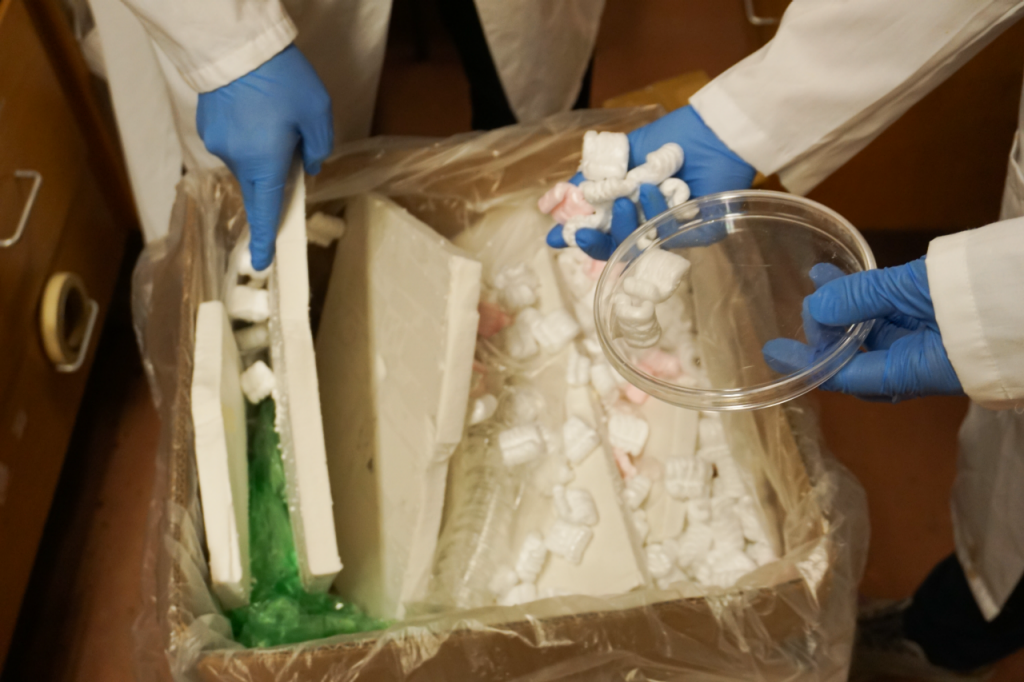The plastic waste that is released into the environment has garnered a lot of attention due to ocean trash and overcrowded landfills. Communities all across the world are exerting a great deal of effort to reduce, reuse, and recycle as a result. But what exactly does the term “recyclable” mean?
 Researchers sort through various objects made from polystyrene, a type of plastic that is rarely recycled. Image Credit: Reilly Henson for Virginia Tech.
Researchers sort through various objects made from polystyrene, a type of plastic that is rarely recycled. Image Credit: Reilly Henson for Virginia Tech.
A research group led by Guoliang “Greg” Liu, an associate professor of chemistry in the College of Science, is hoping to advance the field of plastic recycling.
Numerous people feel comfortable tossing a glass jar or a metal can into the recycle bin. However, plastics are a little unique. Not all recycling facilities are set up to handle all plastic types because different types of plastic materials have different chemistry and structures, necessitating unique recycling processes.
In a perfect world, there might be recycling facilities set up to handle all types of plastic around the globe. But we are not there yet, in part, because some plastics are very challenging to recycle and because efficient, useful methods for processing them have not been created yet.
One such difficult substance is polystyrene. Polystyrene, well recognized as a key ingredient in Styrofoam, is frequently used but seldom recycled. Numerous municipal recycling facilities often advise residents not to place polystyrene in their household recycling containers.
Currently, the primary method for recycling polystyrene results in a product that is usually of minimal quality to make the procedure profitable. To put it another way, if a recycling facility tries to recycle polystyrene on a large scale, it would either require financial support, such as a government subsidy, or the business will risk running out of money and closing.
Making recycling more efficient can help solve this issue by making it more economically viable or, better yet, economically desirable. This is what Liu was able to instruct his team to achieve because of his background in polymer chemistry and affiliation with the Macromolecules Innovation Institute.
The group describes a brand-new technique for recycling polystyrene in a paper that was recently published in the Proceedings of the National Academy of Sciences. This process produces a highly valuable substance called diphenylmethane (DPM) by subjecting the material to ultraviolet light and adding a chemical catalyst.
DPM is utilized as a precursor in the production of polymers, pharmaceutical research, and even as a scent in consumer goods. It is significant that DPM costs ten times more on the market than other products that can currently be created from recycled polystyrene.
The researchers went a step further in their examination to ensure that the new technique would attain the desired level of economic viability. Together with business professionals from Santa Clara University and the Dongbei University of Finance and Economics, the Virginia Tech scientists conducted an analysis to ascertain the overall profitability of the recycling approach.
Their findings demonstrated that the expense of gathering and processing the polystyrene would be entirely justified owing to the great economic value of DPM.
By using this innovative recycling technique, there would be an incentive for polystyrene to be gathered and recycled rather than ending up in landfills or polluting the environment.
I think it is important for people to realize that big global challenges like plastic waste can have—and most likely demand—multiple solutions. We at Virginia Tech can contribute a small piece to the big puzzle and offer solutions to positively impact the world.
Guoliang Liu, Professor, Chemistry, College of Science, Virginia Tech
Journal Reference:
Xu, Z., et al. (2022) Cascade degradation and upcycling of polystyrene waste to high-value chemicals. Proceedings of the National Academy of Sciences. doi:10.1073/pnas.220334611